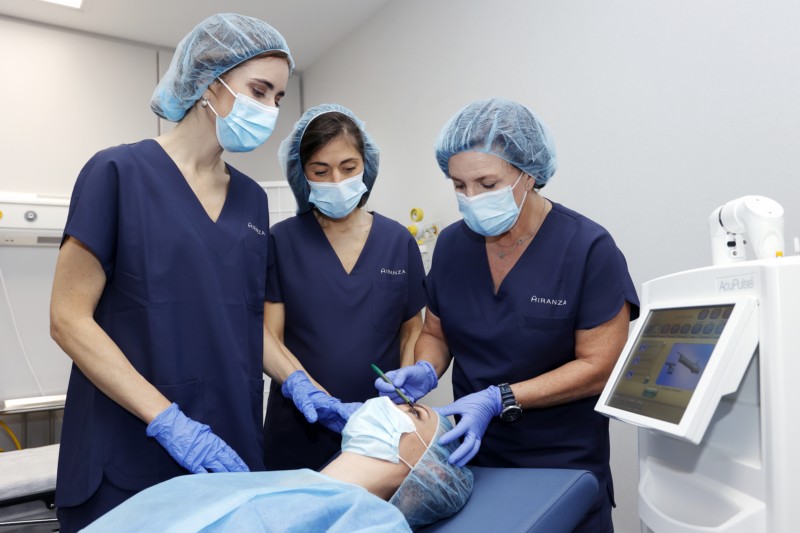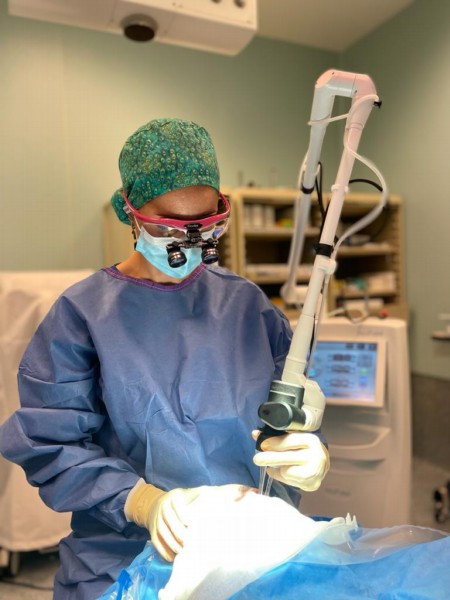AcuPulse CO2 Laser: the most advanced technology for facial rejuvenation
Miranza specialists use this technology to assist in blepharoplasty and to perform resurfacing and minibleph
The ocular and periocular areas are extremely delicate due to their proximity to the eyes and are where most cosmetic issues and signs of ageing from sun exposure and stress are concentrated. This can give us an aged or tired appearance.
Moreover, since the beginning of the pandemic, eyes have become more important, as the continued use of face masks has made us more aware of the state of the skin around our eyes and our ability to transmit and express ourselves through them.
How can we rejuvenate our look?
But how can we rejuvenate our face around the eyes? Some of Miranza’s experts explain the latest technology that we use in our centres and the most popular current techniques for rejuvenating the face and eyes. Dr. Constanza Barrancos, an ophthalmologist specialising in oculoplastics at Miranza IOA, spoints out that “it is important to entrust the rejuvenation of this area of the face to an ophthalmology expert specialising in aesthetics in order to obtain good results, both aesthetic and functional, minimising health risks and ensuring an improved but natural appearance and a speedy recovery”.
Blepharoplasty has become one of the most popular cosmetic eyelid surgeries among patients, both women and men, as it removes excess skin or fat in the upper and lower eyelids to give them a more youthful appearance. This procedure corrects drooping eyelids, as well as bags and dark circles under the eyes, periocular flaccidity, and in general, the appearance of tired or aged eyes.
At Miranza we perform blepharoplasties using the AcuPulse CO2 laser, which allows us to reduce bruising and postoperative swelling and promote a faster recovery.
This laser uses state-of-the-art technology and is commonly used in both surgery and complementary cosmetic treatments. It is specifically indicated for orbito-facial aesthetic rejuvenation, removal of excess skin on the eyelids and bags under the eyes. It improves the tone and appearance of skin, eliminates fine wrinkles, reduces pore size and stimulates collagen renewal.
Its application consists of small pulses of light directed at the area of skin to be treated. Further, shorter pulses can be used, making it more comfortable for the patient.
On the other hand, the blepharoplasty technique can be combined “with other techniques such as resurfacing, in which this laser is also used to boost the other’s effects, reducing subsequent inflammation for faster patient recovery,” says Dr. Concha Romero, a specialist in oculoplastics and oculofacial aesthetics, also at Miranza IOA. Ophthalmologists agree that this technique can be used both in eyelid surgery and in rejuvenation treatments in the area around the eyes.

What is resurfacing?
What is resurfacing? It is an oculofacial aesthetics treatment to renew the skin that offers a powerful rejuvenating effect for the face and the eyes. “The action of resurfacing, for which we also use the CO2 laser, vaporises the superficial layers of the skin and creates thermal columns in the deeper layers by means of small pulses of light,” concludes the doctor.
For her part, Dr. Elena Monzó, from the same centre, highlights another treatment to care for the eyes without the need for surgery. “At Miranza we also perform the minibleph technique, performed with a CO2 laser, which is undoubtedly one of the most requested current trends”.
“The minibleph technique removes and reduces the patient’s wrinkles around the eye and improves the texture and tone of their skin, reducing dark circles, dyschromia and skin laxity, as well as dermatochalasis” (excess skin on the upper eyelid), explains the doctor. Its greatest advantage is that it can be performed in the outpatient consultation room, without the need for surgery to achieve good results.
In any case, before opting for a specific treatment, it is important to receive personalised advice from an expert in this type of surgery and in the application of these techniques. Finally, Dr Monzó specialist at Miranza Ophthalteam reminds us that “an ophthalmologist’s knowledge of the ocular and periocular anatomy is essential to applying these techniques with good judgement and maximum safety”.
Which patients are the best candidates?
The CO2 laser helps eliminate fine wrinkles and stimulates the renewal and production of collagen to perform what we call “photorejuvenation”. It is an ideal technique both on its own and in combination with other treatments.
It is also a very effective treatment for xanthelasmas, small benign tumours or lipid deposits that can appear on the eyelids, mainly due to cholesterol. It also removes other benign skin lesions with minimal scarring.

Post-treatment CO2 Laser care
According to Dr Barbara Bersategui, a specialist at Miranza Clínica Begoña, “One of the key factors to the success of the treatment is post-treatment care, which basically comprises the use of moisturising and healing ointments during the first week”. She also adds: “It is important to apply cold to the area treated with the laser to fight swelling”. In this process, it is essential that the patient applies creams with a high sun protection factor and avoids direct sun exposure during the weeks following the treatment.
The ultimate goal of using the CO2 laser as a technique is to offer each patient an improved version of themselves, with natural – not artificial – looking results. Achieving a beautiful face with the latest technology is now a reality at Miranza.